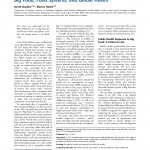 While New Zealand sheepmeat producers have been enjoying a ‘full cup’ in recent times, with strong farmgate returns, a ‘steady hand’ will be needed to balance future production levels with demand uncertainty across European markets.
While New Zealand sheepmeat producers have been enjoying a ‘full cup’ in recent times, with strong farmgate returns, a ‘steady hand’ will be needed to balance future production levels with demand uncertainty across European markets.
A newly released report Sheepmeat – full cup, steady hand from global agribusiness banking specialist, Rabobank, says that the strong farmgate returns in the past two seasons, have been as a result of retail price increases and limited supply availability.
Report co-author Hayley Moynihan says global sheepmeat supplies are forecast to increase from 2013, off a low productive base, although this volume growth is expected to be modest and availability will not recover 2010 levels until 2015.
“While sheepmeat demand has softened in developed markets, we expect retail prices will normalise at new levels – typically 10 percent higher than the three-year average for most regions,” she says.
“For New Zealand producers, a positive outlook will persist in export markets as the economic outlook improves and the market balance remains tipped in their favour.”
As the governments of the EU countries seek to restore balance to their economies, policy changes are expected to place increasing pressure on consumer purchasing powers, says Moynihan. In real terms, the increased cost of living for the average EU consumer is likely to exceed any growth in income, at least for the next 12 to 24 months.
Meat price inflation has led the charge in annual food prices, averaging 4.5 percent year-on-year, with eastern European countries experiencing increases as high as 10 percent in 2011.
“These factors can be expected to weigh heavily on sheepmeat demand and to limit growth prospects.”
Rabobank is picking a slow recovery for developed markets through to the end of 2013. “Emerging markets will continue to grow, albeit slightly below the rate of previous years and offer opportunities for sheepmeat demand growth,” says Moynihan.
The Rabobank report says retail prices will also be influenced by continued strength of competing meat prices; the impact of lower beef production from the US and EU on global supplies; and the rising beef production costs from Brazil, China and Australia..
“These factors are likely to mean that retail price movements for lower-value cuts will continue to rise faster than high-end cuts. This will be particularly evident across emerging economies and consequently only provide limited upward pressure on farmgate returns for exporters,” it says.
Moynihan says that by 2015, sheepmeat production from key exporting regions is expected to lift by an additional 135,000 tonnes a year, which would bring global export supply back to 2010 levels.










